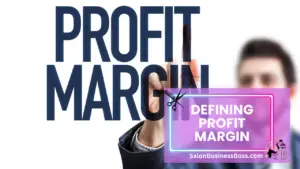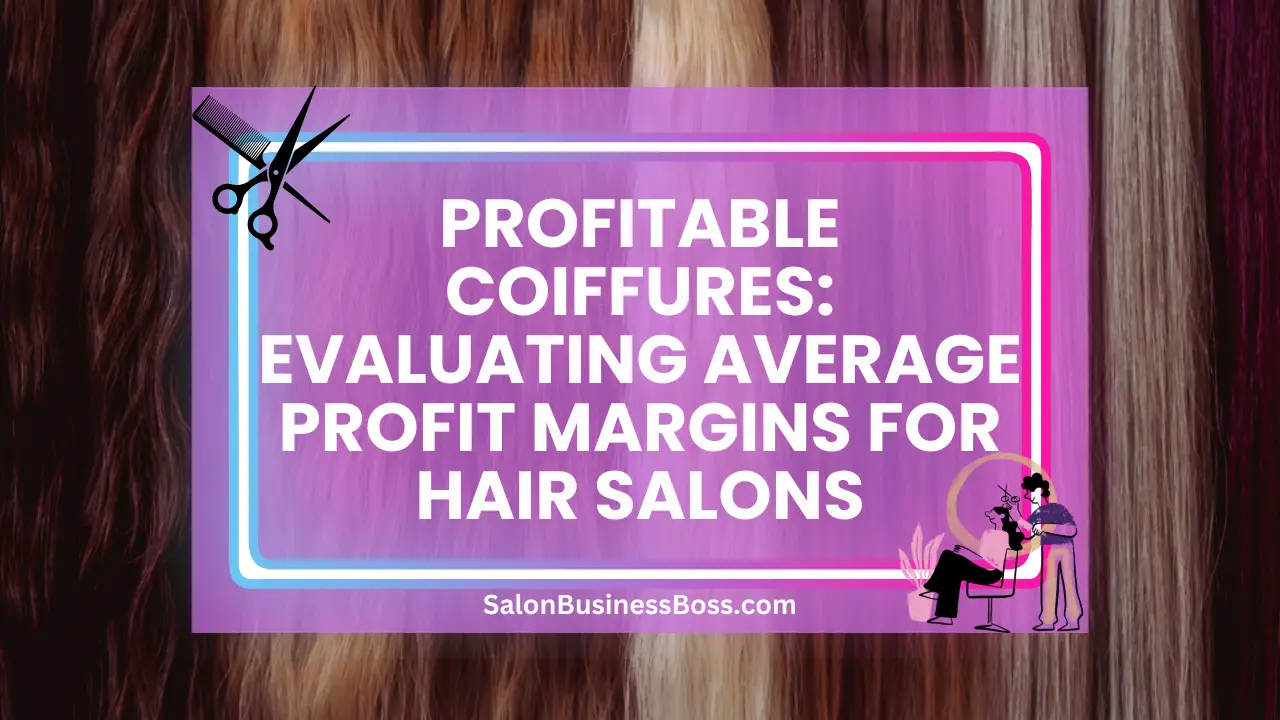The profitability of a hair salon is a critical aspect that directly impacts its sustainability and success. The average profit margin of a hair salon is a key metric that business owners and investors closely monitor to assess the financial health of the salon.
Average profit margin for hair salons typically falls within the range of 2% to 17%. Several factors influence these margins, such as overhead costs, pricing strategies, and service mix. To optimize profitability, salon owners must focus on managing operating costs, emphasizing customer retention, and integrating technology into their operations. By adopting strategic business practices, hair salons can thrive within this profit margin range and ensure long-term success.
1. Defining Profit Margin:

Profit margin is a fundamental financial metric that provides essential insights into the profitability and efficiency of a business, including hair salons. It represents the percentage of revenue that remains as profit after deducting all costs and expenses related to running the salon. By understanding profit margin, salon owners can gauge the effectiveness of their business operations and determine how effectively they convert sales into profits.
A higher profit margin indicates that a salon is generating more profit for every dollar of revenue earned, signifying better financial health and operational efficiency. Conversely, a lower profit margin suggests that a significant portion of revenue is consumed by operating costs, leaving minimal room for profits.
Analyzing profit margin allows salon owners to identify potential areas of improvement. They can focus on reducing costs, streamlining operations, and optimizing service pricing to increase their profit margins. Moreover, it aids in benchmarking the salon’s performance against industry standards and competitors.
Profit margin influences a salon’s long-term sustainability and growth potential. Healthy profit margins provide the necessary capital for reinvestment in the business, staff training, marketing efforts, and facility upgrades, fostering continued success and attracting more customers.
Read more about: Revealing the Norm: Profit Margin in Beauty Salons
2. Factors Influencing Profit Margins:
Several factors can influence the profit margin of a hair salon, making it fluctuate within the range of 2% to 17%. These factors include:
a. Overhead Costs:
Overhead costs represent a significant factor in determining a hair salon’s profit margin. These costs encompass both fixed expenses, such as rent and insurance, and variable expenses, including utilities, staff wages, and inventory. Salons burdened with higher overhead costs may experience narrower profit margins, as a substantial portion of revenue is allocated to covering these essential expenses. To optimize profit margins, salon owners must carefully manage overhead costs by negotiating favorable lease agreements, adopting energy-efficient practices, and implementing cost-effective inventory management. Moreover, efficient staff scheduling and training can reduce labor expenses, contributing to a healthier bottom line. By maintaining a diligent focus on controlling overhead costs, hair salons can bolster profitability and ensure sustainable financial success.
b. Pricing Strategy:
A well-crafted pricing strategy is pivotal in shaping a hair salon’s profit margins. The pricing of services directly influences customer perceptions and willingness to pay, impacting revenue generation. Salons offering premium services at higher prices often enjoy wider profit margins, as they cater to clientele seeking superior experiences and results. On the other hand, salons offering discounted services may attract more price-conscious customers but may experience narrower profit margins due to reduced per-service revenue. Striking the right balance between pricing and value proposition is crucial. Salon owners should consider factors such as service quality, expertise, and local market competition when determining pricing. By aligning pricing with the salon’s unique selling points, profit margins can be optimized while maintaining customer satisfaction and loyalty.
c. Salon Location:
The geographical location of a hair salon plays a pivotal role in determining its profitability and, consequently, its profit margins. Salons situated in prime, high-traffic areas often benefit from increased visibility and footfall, leading to higher customer volumes and revenue generation. The enhanced exposure in such locations provides the potential for a broader client base and more significant upselling opportunities, ultimately impacting the profit margin positively. However, these locations may also come with higher rental costs, which can affect overhead expenses. On the other hand, salons in less bustling areas may have lower rental costs, but they might face challenges in attracting sufficient clientele to maintain robust profit margins. Selecting an ideal salon location that strikes a balance between visibility, accessibility, and affordability is crucial for optimizing profitability.
d. Staff Efficiency:
The skills, productivity, and professionalism of salon staff directly influence the salon’s revenue generation and, consequently, its profit margins. Efficient and well-trained staff can serve more clients effectively, leading to higher service utilization and increased revenue. Moreover, satisfied clients are more likely to become repeat customers, fostering customer retention and further contributing to profit margins. Salon owners should invest in continuous staff training to enhance their expertise and stay updated on industry trends. Additionally, optimizing staff scheduling based on demand patterns can ensure that the salon operates at optimal capacity, maximizing service efficiency and profitability. By prioritizing staff development and efficiency, hair salons can elevate their profit margins while maintaining exceptional service standards.
e. Marketing and Promotion:
Effective marketing and promotion strategies are essential for boosting customer footfall, generating higher revenues, and widening profit margins. By effectively communicating the salon’s unique selling points and services through various marketing channels, such as social media, print ads, and partnerships with local businesses, salons can attract a more extensive customer base. Targeted promotions and loyalty programs can encourage repeat business, increasing customer retention and lifetime value. As the salon gains visibility in the market, it can position itself as a go-to destination for beauty and haircare needs, enabling it to charge premium prices and enjoy improved profit margins. Investing in strategic marketing efforts that resonate with the salon’s target audience is an indispensable tool for enhancing profitability and maintaining a competitive edge in the beauty industry.
3. The Impact of Services Mix:
The services mix offered by a hair salon plays a crucial role in determining its overall profit margin. Each service comes with its own cost structure, resource utilization, and demand levels, which directly influence profitability. For instance, basic haircuts may yield lower profit margins due to their relatively lower prices and quicker service times, whereas specialty services like hair coloring, extensions, and advanced treatments may command higher prices and offer more significant profit potential.
To optimize profit margins, salon owners must conduct a thorough analysis of the profitability of each service. This involves assessing the cost of materials, time, and labor required to provide each service and comparing it with the revenue generated. By identifying services with lower profit margins and those with higher profitability, salon owners can strategically adjust their service mix.
Emphasizing high-margin services and promoting them effectively can lead to increased revenue and improved profit margins. Moreover, salon owners may consider bundling complementary services or introducing package deals to encourage customers to try multiple services, thereby enhancing overall revenue and profitability.
4. Managing Operating Costs:

Minimizing operating costs is paramount to achieving and maintaining a healthy profit margin in a hair salon. Salon owners must continually review their expenses and identify areas where cost-cutting measures can be implemented without compromising the quality of services provided.
One effective strategy is to negotiate better deals with suppliers for hair products, equipment, and other salon essentials. Building strong relationships with suppliers and buying in bulk can often lead to discounts and cost savings.
Optimizing staff scheduling is another way to manage operating costs. By aligning staff schedules with peak demand hours and efficiently managing breaks, salon owners can ensure optimal productivity while minimizing labor costs.
Investing in energy-efficient technologies, such as LED lighting and energy-saving appliances, can also contribute to cost reductions in the long run. These investments not only lower utility expenses but also demonstrate the salon’s commitment to sustainability, which can appeal to environmentally-conscious customers.
Monitoring and controlling inventory levels can prevent waste and overstocking, leading to better cost management. Utilizing salon management software can streamline inventory control and improve overall operational efficiency.
Read more about: How Much Does It Cost to Open a Hair Salon: Average Startup Costs
5. Upselling and Cross-Selling:
Upselling and cross-selling techniques are powerful tools that can significantly impact a hair salon’s profit margin. By encouraging stylists to recommend additional services, hair products, or treatments to clients during the consultation process, salons can increase the average transaction value and boost overall profitability.
When a stylist suggests complementary services or products that align with the client’s needs and preferences, it enhances the overall customer experience. Upselling can involve suggesting a higher-tier service, such as a premium hair treatment alongside a regular haircut. Cross-selling, on the other hand, can involve recommending hair care products, styling tools, or retail items that complement the services availed.
Effective communication and a personalized approach are essential for successful upselling and cross-selling. By demonstrating genuine interest in the client’s well-being and offering tailored recommendations, stylists can build trust and credibility, making clients more receptive to additional offerings.
Salons can further incentivize upselling and cross-selling efforts by rewarding stylists for achieving higher sales or incorporating commission-based structures. Investing in staff training on effective upselling techniques can also pay dividends in increasing average transaction values and ultimately improving the salon’s profit margin.
6. Emphasizing Customer Retention:
Customer retention is a pivotal factor in ensuring a stable revenue stream and maximizing profit margins for hair salons. Loyal customers are more likely to become repeat clients and are often willing to explore higher-value services as they grow comfortable with the salon’s expertise and quality of service.
Implementing customer retention strategies can strengthen the salon’s relationship with clients and foster long-term loyalty. Offering loyalty programs, where clients earn points or rewards based on their repeat visits or referrals, incentivizes them to choose the salon for their haircare needs consistently.
Personalized discounts or special offers can be extended to regular customers as a token of appreciation for their loyalty. By acknowledging and rewarding their patronage, the salon can reinforce the connection with clients and encourage them to continue using the salon’s services.
Exceptional customer service is a cornerstone of customer retention. Ensuring that clients have positive experiences during each visit can leave a lasting impression and increase the likelihood of them returning. Addressing concerns promptly, actively listening to feedback, and going the extra mile to exceed expectations can build strong customer loyalty.
Long-term customer relationships translate to a higher customer lifetime value (CLV) as clients are more likely to spend more on services over time. This enhanced CLV, coupled with reduced customer acquisition costs compared to attracting new clients, contributes to improved profit margins and a stable, thriving business for the salon.
7. Technology Integration:
Incorporating technology into hair salon operations through salon management software and online booking systems can lead to substantial improvements in efficiency and profitability. By automating various tasks, such as appointment scheduling, inventory management, and customer data management, salon owners can optimize resource allocation and reduce operational inefficiencies.
With salon management software, salon staff can efficiently manage appointments and reduce the likelihood of double-bookings or scheduling conflicts. This streamlines the client experience and ensures that stylists are effectively utilizing their time, which can lead to increased service capacity and higher revenue generation.
Inventory management features enable salon owners to monitor product levels in real-time, helping to avoid stockouts and excessive inventory, which can tie up capital unnecessarily. By maintaining optimal inventory levels, salons can minimize carrying costs and free up resources to be invested in other areas of the business.
8. Industry Benchmarks:

Benchmarking a hair salon’s profit margin against industry standards is a valuable practice that provides crucial insights into its financial performance and competitiveness. Industry benchmarks are typically calculated based on comparable salons in terms of size, location, and services offered.
Comparing the salon’s profit margin to industry benchmarks helps identify areas for improvement and allows salon owners to gauge their performance relative to their peers. If a salon’s profit margin falls below industry averages, it may indicate inefficiencies or missed opportunities that warrant attention.
Achieving profit margins that align with or surpass industry benchmarks is indicative of a well-managed and financially healthy salon. It demonstrates that the salon is competitively priced, delivering quality services, and effectively managing operating costs.
Benchmarking also fosters continuous improvement and strategic decision-making. Salon owners can analyze successful practices adopted by top-performing salons in the industry and implement similar strategies to enhance their profitability.
Read more about: Revealing the Norm: Profit Margin in Beauty Salons
Conclusion
The average profit margin of a hair salon between 2% and 17% reflects the complexity of managing a successful business in this industry. Salon owners must consider a multitude of factors, from operating costs to service mix and customer retention, to optimize their profitability. By employing strategic business practices, embracing technological advancements, and consistently focusing on delivering quality services, salon owners can navigate within this profit margin range and thrive in the competitive world of hair care services.
Frequently Asked Questions

1. How important is customer retention for improving profit margins?
Customer retention is vital for stable revenue streams and higher profit margins. Implement loyalty programs, personalized discounts, and excellent customer service to foster long-term client relationships.
2. Can technology integration help improve profit margins?
Yes, technology integration, such as salon management software and online booking systems, can streamline operations, save time and resources, and positively impact profit margins.
3. How can I stay competitive with other hair salons in terms of profit margins?
Comparing your salon’s profit margins to industry benchmarks can help you identify areas for improvement and ensure competitiveness within the market.
To learn more on how to start you own salon checkout my startup documents here.
Please note that the contents of this blog are for informational and entertainment purposes only and should not be construed as legal advice. Any action taken based on the information provided in this blog is solely at your own risk. Additionally, all images used in this blog are generated under the CC0 license of Creative Commons, which means they are free to use for any purpose without attribution.

About the author. Entrepreneur and Salon Business Fan.
Hi! I am Shawn and I am a happy individual who happens to be an entrepreneur. I have owned several types of businesses in my life from a coffee shop to an import and export business to an online review business plus a few more and now I create online salon business resources for those interested in starting new ventures. It’s demanding work but I love it. I do it for those passionate about their business and their goals. That’s why when I meet a salon business owner, I see myself. I know how hard the struggle is to retain clients, find good employees and keep the business growing all while trying to stay competitive.
That’s why I created Salon Business Boss: I want to help salon business owners like you build a thriving business that brings you endless joy and supports your ideal lifestyle.

